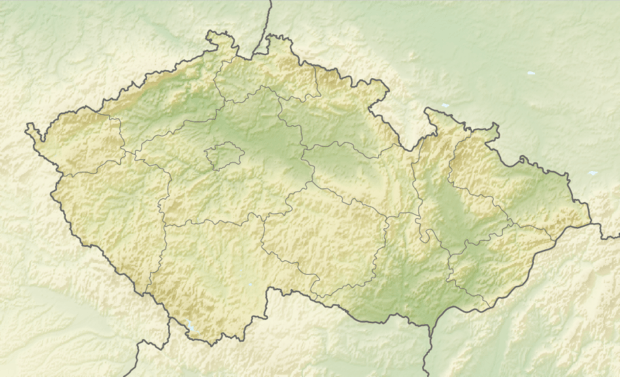Zákupy
Zákupy (Czech pronunciation: [ˈzaːkupɪ]; German: Reichstadt) is a town in the Česká Lípa District in the Liberec Region of the Czech Republic. It has about 2,900 inhabitants. The centre of the town and the castle are historically significant and since 2003 they are protected by law as Urban monument zone.
Zákupy | |
|---|---|
Town | |
 Zákupy Castle | |
 Flag  Coat of arms | |
 Zákupy Location in the Czech Republic | |
| Coordinates: 50°41′29″N 14°39′4″E | |
| Country | |
| Region | Liberec |
| District | Česká Lípa |
| First mentioned | 1315 |
| Government | |
| • Mayor | Radek Lípa |
| Area | |
| • Total | 32.27 km2 (12.46 sq mi) |
| Elevation | 271 m (889 ft) |
| Population (2020-01-01[1]) | |
| • Total | 2,851 |
| • Density | 88/km2 (230/sq mi) |
| Time zone | UTC+1 (CET) |
| • Summer (DST) | UTC+2 (CEST) |
| Postal code | 471 23 |
| Website | www |
Geography
The town is located in the north of the historic Bohemia region, on the Svitávka River near its junction with the Ploučnice.
History
Early history
The fortress of Richinstadt was mentioned in a 1315 deed. The Czech name Zákupy first appeared in 1352, probably denoting two villages beneath the fort, which grew together over the centuries. Zákupy was referred to as a market town (městečko) already in 1359.
The estates were held by Bohemian nobles like the Panczer dynasty, from 1363 by the Lords of Wartenberg, who sold Zákupy to the Berka z Dubé noble family in 1460–63. They erected a Renaissance castle on the foundations from 1541 to 1552 and rebuilt the adjacent town with its parish church. The city rights were confirmed by the Habsburg emperor Rudolf II, King of Bohemia, in 1582.
During the Thirty Years' War, the town and castle were acquired by the Imperial field marshal Julius Henry of Saxe-Lauenburg in 1632, and devastated by Swedish troops shortly afterwards. His son Julius Francis had it rebuilt in a Baroque style. The last heiress, Anna Maria Franziska of Saxe-Lauenburg, died at Reichstadt Castle in 1741. Her daughter was married to Ferdinand Maria Innocenz of Bavaria and hence the possessions went to his family.
Duke of Reichstadt
In 1805, the estates were purchased by the Habsburg archduke Ferdinand III. In 1818, Emperor Francis I of Austria awarded the title of Duke of Reichstadt (German: Herzog von Reichstadt) to his grandson, Napoleon Franz, who was the son of Emperor Napoleon I and Empress Marie Louise.[2] Napoleon Franz died without heirs in 1832, having never visited the town.
Later history
After his resignation in 1848, Emperor Ferdinand I of Austria took over the management of the Reichstadt manor, with considerable success. He used the castle as a summer residence and had the interior lavishly decorated. Upon his death in 1875, the property went to Emperor Franz Joseph.
On 8 July 1876, Russia's Chancellor Alexander Gorchakov and Austria's Emperor Franz Joseph reached the Reichstadt Agreement on the following Russo-Turkish War and the partition of the Balkans at the castle. Archduke Franz Ferdinand of Austria and Countess Sophie Chotek of Chotkov were married there on 1 July 1900.
In October 1938, the town was annexed by Nazi Germany according to the Munich Agreement and incorporated into the Reichsgau Sudetenland. After World War II, the German population was expelled.
Notable people
- Meda Mládková (born 1919), art collector
References
- "Population of Municipalities – 1 January 2020". Czech Statistical Office. 2020-04-30.
- German description of the majorat of the Duke of Reichstadt, circa 1830.
